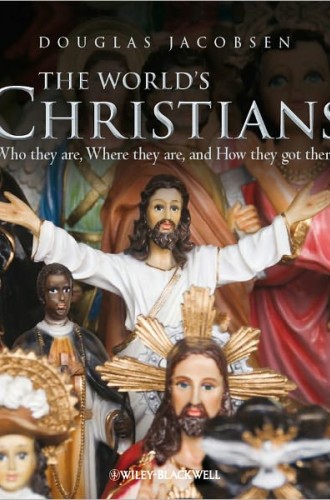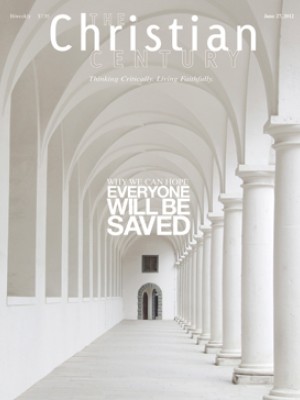The World’s Christians, by Douglas Jacobsen
Shortly after the end of World War II, the Maryknoll order’s John J. Considine, an ecumenically minded missiologist who had visited virtually every major center of Christian missionary activity in the world, was one of the first to use the phrase “world Christianity,” when he said, “Christianity is not true Christianity unless it embraces all mankind—unless it is world Christianity.” In his little book called World Christianity, Considine used the phrase to describe both the theological essence of Christianity and what was coming into being as a social reality in the late 1940s.
Nearly 70 years later, Douglas Jacobsen has written a comprehensive survey of what that movement has become. A professor of church history at Messiah College in Grantham, Pennsylvania, Jacobsen is the author of a well-received study of the theologies of early Pentecostalism (Thinking in the Spirit) and, with his wife Rhonda Jacobsen, editor of the highly regarded The American University in a Postsecular Age. He is one of the most reliable and insightful scholars of world Christianity writing today.
Read our latest issue or browse back issues.
The World’s Christians is divided into three parts that correspond to the subtitle of his book: one part each to tell who the world’s Christians are, where they are and how they got there. Jacobsen gives an overview of the history and basic characteristics of the four principal Christian traditions: Orthodox, Catholic, Protestant and Pentecostal/Charismatic.
The overviews are accurate and up-to-date, though it seems odd to begin Catholicism in the 11th century. It is true, of course, that the reforms of canon lawyers led to the development of a more uniform, papally centered Western church at about that time. Still, it’s not a minor quibble to note this oddity in a book that so successfully draws on the self-understanding of the other three traditions to tell the reader who the world’s Christians are. For even Catholics who do not think that the apostle Peter’s ministry evolved into a full-blown imperial papacy trace the evolution of the papacy to a process already under way in the second and third centuries and attested to by Mediterranean documents of that time, when bishops of Rome were spoken of as Peter’s successors to whom at least a primacy of honor was due. That reservation aside, Jacobsen masterfully sketches the nine geographical areas where the world’s Christians are.
The term world Christianity has been widely used since the publication of Philip Jenkins’s 2002 best seller The Next Christendom, but in popular usage it has tended—mistakenly, in my view—to refer only to Christianity in the Global South. Though courses on world Christianity have proliferated in colleges, universities and seminaries, no one until Jacobsen has taken the care to delineate the historical, demographic and theological contours of the entire global movement.
Writing on world Christianity tends to idealize people living in the Global South, and it tends to lump churches together and avoid portraying their particularities and their social realities. Progressive writers, for example, may avoid bringing into relief such matters as the visceral rejection of homosexuality by many African, Asian and Latin American Christians. Evangelical writers tend to trumpet that abhorrence, saying that it is consonant with ancient Israel’s views and with authentic Christianity. In other words, writers tend to praise or to be silent about various realities as doing so suits their domestic agenda.
This is not a new problem for interpreters of Christianity “beyond the West.” The first rapporteurs wrote not only to inform people in their home countries about their work but also to attract recruits to the mission field and money to carry on the work. There were exceptions, to be sure. In his Spiritual Revolution in the East (1940), the Protestant German missiologist Walter Freytag went to great lengths to explain the social and political situation in churches he visited in the late 1930s in New Guinea, Indonesia, India and China. But we realize now how premature was Freytag’s conviction that in New Guinea, for instance, “sorcery has been abjured and the objects of magic destroyed.” The fact that traditional rituals, including sorcery, are still practiced by many Christians is not mentioned even today in polite circles.
Freytag was unusually farseeing, but even he felt the need to make indigenous Christianity inspiring and familiar to his European readers, and he did not report the full width of the cultural gap between it and the Christianity of the “sending country.” And he knew that his European audience was incapable of giving up its presupposition that it represented civilization and that African and Oceanic traditions were primitive.
Why raise this issue in relation to Jacobsen’s book? Because the task he has undertaken and so well accomplished should be judged by how well he introduces the many textures of a world faith that is certainly rooted in Jesus of Nazareth, but also in the histories and cultures of its adherents—cultures that today are often in distress.
Jacobsen situates the four basic Christian traditions in nine carefully delineated geographical areas: the Middle East and North Africa, Eastern Europe, Central and South Asia, Western Europe, sub-Saharan Africa, East Asia, Latin America, North America and Oceania. With depth and acuity, Jacobsen offers judicious assessments of the religious and cultural characteristics of each area and the shapes of Christianity in each.
Ultimately, however, I was left with a few questions. Can world Christianity become a true, multicultural communion of brothers and sisters? Can Christians in one hemisphere break out of their habit of viewing believers in another as true Christians only to the extent that, for example, they share their ideas on sexual ethics and gender identity? Can they feel one with others who differ? Can Presbyterians in, say, Malawi participate with American Presbyterians as cherished equals in the Reformed movement? Is this even a goal, or are Protestants trapped in national denominations? On the other hand, can Catholics do better than attempt to enforce global uniformity in liturgy and ordination policies?
On biblical grounds, the universality of Christian life lies in the one Spirit knitting peoples into the one body of Christ. Jacobsen provides readers with the best available picture of diversity and the challenges to consciously becoming one body. Diversity is not going away, and events of the past several years make one wonder whether Christians are prepared to live with the restraint that communion demands when believers in one culture are not prepared to give up their traditions simply because another culture is changing.
The theological question is whether, in the midst of the plurality that Jacobsen reveals, a new kind of ecumenism will develop that is big enough to recognize a deeper unity in Christ—and then to produce the love that will make a difference.






